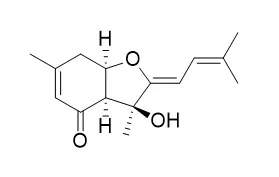| Description: |
Bisabolangelone has anti-tumor, anti-inflammatory, anti-microbial, and antioxidant activities, it inhibits dendritic cell functions by blocking MAPK and NF-κB signaling. Bisabolangelone has antimelanogenic activity, the cAMP-binding site of PKA as a putative target ameliorating melanocyte-specific hyperpigmented disorder. Bisabolangelone has anti-ulcer activity, it is possible that bisabolangelone inhibited the activity of the H(+)/K(+)-ATPase, then reducing the secretion of H(+). It also inhibits the activity of 5alpha-reductase type I in LNCaP cells (IC50 = 11.6 microg/ml). |
| Targets: |
TNF-α | IL Receptor | MAPK | NF-kB | p65 | cAMP | PKA | GABA Receptor | NO | PGE | ATPase | Potassium Channel |
| In vitro: |
| Fitoterapia. 2011 Apr;82(3):434-40. | | HPLC-based activity profiling of Angelica pubescens roots for new positive GABAA receptor modulators in Xenopus oocytes.[Pubmed: 21147202] | A petroleum ether extract of the traditional Chinese herbal drug Duhuo (roots of Angelica pubescens Maxim. f. biserrata Shan et Yuan), showed significant activity in a functional two-microelectrode voltage clamp assay with Xenopus oocytes which expressed recombinant γ-aminobutyric acid type A (GABA(A)) receptors of the subtype α(1)β(2)γ(2S).
METHODS AND RESULTS:
HPLC-based activity profiling of the active extract revealed six compounds responsible for the GABA(A) receptor modulating activity. They were identified by microprobe NMR and high resolution mass spectrometry as columbianetin acetate (1), imperatorin (3), cnidilin (4), osthol (5), and columbianedin (6). In concentration-dependent experiments, osthol and cnidilin showed the highest potentiation of the GABA induced chloride current (273.6%±39.4% and 204.5%±33.2%, respectively at 300 μM). Bisabolangelone (2) only showed minor activity at the GABA(A) receptor.
CONCLUSIONS:
The example demonstrates that HPLC-based activity profiling is a simple and efficient method to rapidly identify GABA(A) receptor modulators in a bioactive plant extract. | | Planta Med. 2011 Feb;77(3):248-51. | | Hypopigmenting activity of bisabolangelone isolated from Angelica koreana Maxim. in α-melanocyte stimulating hormone-activated B16 or melan-a cells.[Pubmed: 20814852 ] | Tyrosinase is a key enzyme in the biosynthetic pathway of melanin pigments. Abnormal accumulation of melanin pigments causes melasma, freckles, and senile lentigo, which can be substantially ameliorated by treatment with arbutin or other tyrosinase inhibitors.
METHODS AND RESULTS:
In this study, roots of Angelica koreana Maxim. (Umbelliferae) inhibited melanin production in α-melanocyte stimulating hormone ( α-MSH)-activated B16 melanoma cells or melan-a melanocytes. To elucidate the hypopigmenting principle of A. koreana, the plant extracts were subjected to bioassay-guided phytochemical analysis, resulting in the identification of Bisabolangelone. Bisabolangelone dose-dependently inhibited α-MSH-induced melanin production in B16 or melan-a cells with IC(15) values of 9-17 µM. The positive control arbutin also inhibited melanin production in B16 cells with an IC(50) value of 317 µM. Bisabolangelone suppressed α-MSH-inducible protein levels of tyrosinase in B16 cells but could not significantly inhibit the catalytic activity of cell-free tyrosinase.
CONCLUSIONS:
Taken together, this study indicates that Bisabolangelone is the primary hypopigmenting principle of A. koreana and may have pharmacological potential in the melanin-associated hyperpigmentation disorders. | | Int Immunopharmacol. 2010 Feb;10(2):155-62. | | Bisabolangelone isolated from Ostericum koreanum inhibits the production of inflammatory mediators by down-regulation of NF-kappaB and ERK MAP kinase activity in LPS-stimulated RAW264.7 cells.[Pubmed: 19879381 ] | Bisabolangelone, a sesquiterpene derivative, was isolated from the roots of Osterici Radix (Ostericum koreanum Maximowicz).
METHODS AND RESULTS:
In this study, the anti-inflammatory effect of Bisabolangelone was investigated to address potential therapeutic effects in lipopolysaccharide (LPS)-stimulated mouse macrophage RAW 264.7 cells. Bisabolangelone significantly inhibited NO, PGE(2), and pro-inflammatory cytokines by suppressing the mRNA and protein expressions of iNOS and COX-2. Bisabolangelone also inhibited the productions of pro-inflammatory cytokines (TNF-alpha, IL-1beta and IL-6) by suppressing the cytokine mRNA and protein expressions. The molecular mechanism of Bisabolangelone-mediated attenuation in RAW 264.7 cells has a close relationship to suppressing the translocation of nuclear factor-kappaB (NF-kappaB) p65 subunit into the nucleus and the phosphorylation of mitogen-activated protein kinases (MAPKs).
CONCLUSIONS:
These results indicate that Bisabolangelone inhibits LPS-stimulated inflammation through the blocking of NF-kappaB and MAPK pathways in macrophages, and demonstrated that Bisabolangelone possesses anti-inflammatory properties. |
|
| In vivo: |
| J Ethnopharmacol. 2009 Jun 22;123(2):343-6. | | The anti-ulcer activities of bisabolangelone from Angelica polymorpha.[Pubmed: 19429382 ] | Evaluate the anti-ulcer effects of Bisabolangelone from Angelica polymorpha Maxim and provide the basic data to further study for the Angelica polymorpha and Bisabolangelone.
METHODS AND RESULTS:
Bisabolangelone was isolated from Angelica polymorpha Maxim collected from Shennongjia Forest District of China. The structure of Bisabolangelone was elucidated by NMR and MS spectrums. The anti-ulcer effects were evaluated with length of lesion (mm) and activity of H(+)/K(+)-ATPase in two models induced by ethanol and Pylorus ligation. Experimental groups were administered with different doses of Bisabolangelone (3.8, 7.6 and 15.3 mg/kg). The positive control group was administered omeprazole with a dose of 3.3 mg/kg.
Bisabolangelone significantly reduced the length of lesion (3.8, 7.6 and 15.3 mg/kg, P<0.01), inhibited the activity of H(+)/K(+)-ATPase (3.8, 7.6 and 15.3 mg/kg, P<0.01), decreased the volume of gastric juice (7.6 and 15.3 mg/kg, P<0.05), and increased the pH value of gastric juice (7.6 and 15.3 mg/kg, P<0.01, 3.8 mg/kg, P<0.05).
CONCLUSIONS:
Bisabolangelone is the main anti-ulcer active compound of Angelica polymorpha, and remarkably preventive and therapeutic action on gastric ulcer. It is possible that Bisabolangelone inhibited the activity of the H(+)/K(+)-ATPase, then reducing the secretion of H(+), and the anti-ulcer mechanism of Bisabolangelone was deserved to be further studied. |
|






 Cell. 2018 Jan 11;172(1-2):249-261.e12. doi: 10.1016/j.cell.2017.12.019.IF=36.216(2019)
Cell. 2018 Jan 11;172(1-2):249-261.e12. doi: 10.1016/j.cell.2017.12.019.IF=36.216(2019) Cell Metab. 2020 Mar 3;31(3):534-548.e5. doi: 10.1016/j.cmet.2020.01.002.IF=22.415(2019)
Cell Metab. 2020 Mar 3;31(3):534-548.e5. doi: 10.1016/j.cmet.2020.01.002.IF=22.415(2019) Mol Cell. 2017 Nov 16;68(4):673-685.e6. doi: 10.1016/j.molcel.2017.10.022.IF=14.548(2019)
Mol Cell. 2017 Nov 16;68(4):673-685.e6. doi: 10.1016/j.molcel.2017.10.022.IF=14.548(2019)